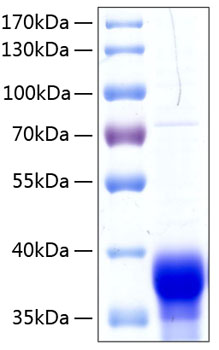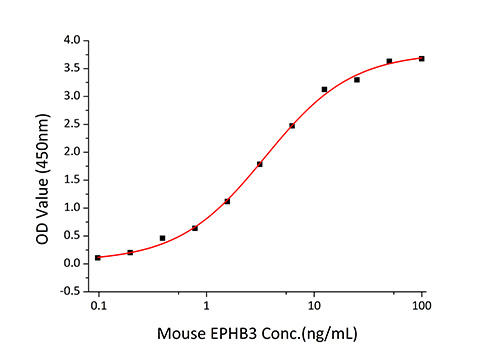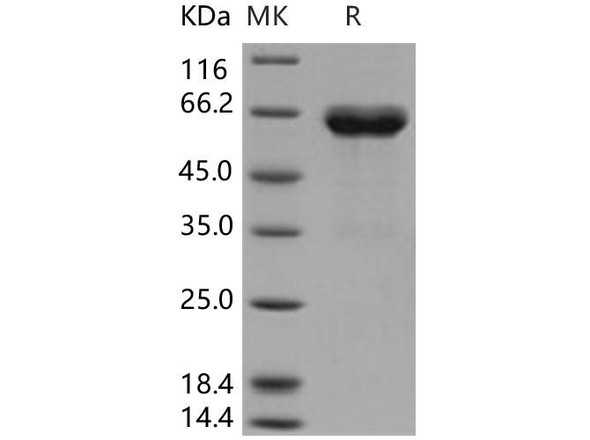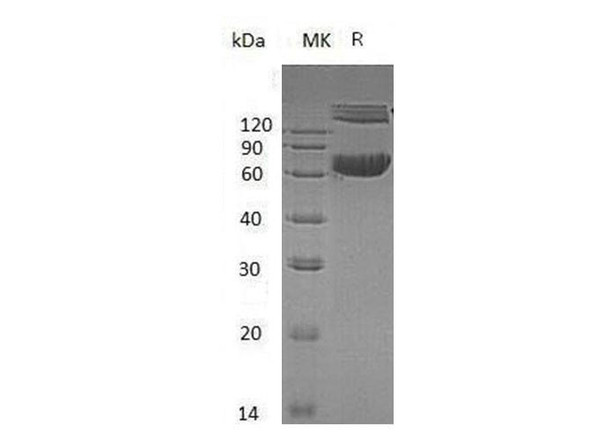Description
Recombinant Human Ephrin-B1/EFNB1 Protein
The Recombinant Human Ephrin-B1/EFNB1 Protein is a biologically active recombinant protein that plays a significant role in various cellular processes and signaling pathways in human biology. This protein is widely employed in immunological research, cell biology studies, protein-protein interaction analyses, and therapeutic development, providing researchers with a reliable tool for investigating Ephrin-B1/EFNB1 function and its implications in health and disease.
This product (SKU: RPCB0283) is produced using HEK293 cells and features a C-His tag for convenient detection and purification. The protein exhibits a calculated molecular weight of 23.24 kDa with an observed molecular weight of 35-40 kDa under denaturing conditions, achieving ≥ 95 % as determined by SDS-PAGE.. Functional bioactivity has been validated through rigorous quality control assays, confirming its suitability for demanding research applications.
Key Features
| High Purity by Affinity Chromatography | |
| Mammalian & Bacterial Expression Systems | |
| High lot-to-lot consistency via strict QC |
| Product Name: | Recombinant Human Ephrin-B1/EFNB1 Protein |
| SKU: | RPCB0283 |
| Size: | 20 μg , 50 μg , 100 μg |
| Reactivity: | Human |
| Synonyms: | EFNB1, CFND, CFNS, EFB1, EFL3, EPLG2, Elk-L, LERK2, ephrin-B1 |
| Tag: | C-His |
| Expression Host: | HEK293 cells |
| Calculated MW: | 23.24 kDa |
| Observed MW: | 35-40 kDa |
| Gene ID: | 1947 |
| Protein Description: | High quality, high purity and low endotoxin recombinant Recombinant Human Ephrin-B1/EFNB1 Protein (RPCB0283), tested reactivity in HEK293 cells and has been validated in SDS-PAGE.100% guaranteed. |
| Endotoxin: | < 0.1 EU/μg of the protein by LAL method. |
| Purity: | ≥ 95 % as determined by SDS-PAGE. |
| Formulation: | Lyophilized from a 0.22 μm filtered solution of PBS, pH 7.4.Contact us for customized product form or formulation. |
| Bio-Activity: | Measured by its binding ability in a functional ELISA. Immobilized Human EFNB1 at 0.5 μg/mL (100 μL/well) can bind Mouse EPHB3 with a linear range of 0.1-3.5 ng/mL. |
| Reconstitution: | Centrifuge the vial before opening. Reconstitute to a concentration of 0.1-0.5 mg/mL in sterile distilled water. Avoid vortex or vigorously pipetting the protein. For long term storage, it is recommended to add a carrier protein or stablizer (e.g. 0.1% BSA, 5% HSA, 10% FBS or 5% Trehalose), and aliquot the reconstituted protein solution to minimize free-thaw cycles. |
| Storage: | Store at -20℃.Store the lyophilized protein at -20℃ to -80 ℃ up to 1 year from the date of receipt. After reconstitution, the protein solution is stable at -20℃ for 3 months, at 2-8℃ for up to 1 week. |
Ephrin-B1 also known as EFNB1, is a member of the ephrin family. The transmembrane- associated ephrin ligands and their Eph family of receptor tyrosine kinases are expressed by cells of the SVZ. Eph/ephrin interactions are implicated in axon guidance, neural crest cell migration, establishment of segmental boundaries, and formation of angiogenic capillary plexi. Eph receptors and ephrins are divided into two subclasses, A and B, based on binding specificities. Ephrin subclasses are further distinguished by their mode of attachment to the plasma membrane: ephrin-A ligands bind EphA receptors and are anchored to the plasma membrane via a glycosylphosphatidylinositol (GPI) linkage, whereas ephrin-B ligands bind EphB receptors and are anchored via a transmembrane domain. An exception is the EphA4 receptor, which binds both subclasses of ephrins.








